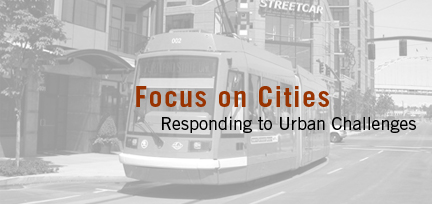|

City as a Stage: Placemaking for the Performing Arts
Los Angeles , CA
Apr 10, 2010
The public's engagement in arts and culture has dramatically changed since many of our civic arts centers in the U.S. were constructed decades ago. This discussion, a Bruner-Loeb Forum (www.brunerloeb.org), will explore both innovative "re-purposing" of mid-century developments like the Music Center, while imagining the civic arts spaces of the future.
Overview
Forty to fifty years ago, leaders in U.S. cities began developing large cultural centers that affirmed civic identity. Wealthy citizens in collaboration with the resources and authority of local government planned and built grand concert halls, theatres, and art museums. The resulting architecture in prime city spaces trumpeted the city's coming of age. Instilling a sense of social/cultural center, these places sought both to develop local cultural resources and to present talent from out of town. These centers remain an important investment of public resources, yet at the same time, the public's modes of engagement with culture continue to evolve and change.
The traditional idea of a central performing arts center---a cluster of varying sizes of formal, often proscenium, stages anchoring the arrangement with secondary, informal, often smaller spaces devoted to other activities---cannot presume to be the sure-footed marker of civic cultural engagement it once was. The proscenium format itself began to lose its overwhelming popularity before the establishment of the first modern civic cultural centers when the first strains of live radio broadcast concerts wafted into our homes. The dominance of live performance slipped a little further when our living rooms began to glow with the bright blue light of television screens. Now, with the rise of the internet age, the manner, habits and expectations of the public and their engagement with the arts and culture has even further, and profoundly, shifted.
This shift raises some important questions to those involved in urban life. What approach to design is appropriate going forward given the changing nature of how the public engages with culture? What are the characteristics of a design that looks toward the evolving nature of arts and culture engagement? What should a civic development profiling arts and culture and promoting cultural engagement look like now? Using the example of the late mid-century rise of the civic performing arts center as a starting point, this forum launches a national discussion about both the development of new and the renewal of existing centers.
By bringing together people involved in urban arts, from both an active, ephemeral arts perspective, and from an architectural perspective, the Forum is intended to stimulate a dialogue about what kinds of settings and places support contemporary performance art, and about how cities might best support their creation and sustainability. Some of the most pertinent questions might include: What kinds of physical environments support new ephemeral, and/or festival-like spaces? How can existing structures be repurposed so that they embrace/facilitate new modes of engagement? What are the salient characteristics of new buildings designed for the performing arts? How can use of technology further democratize traditional performing arts centers (spaces to accommodate ocarina I-phone users and Rock Band players?)
The Forum will be structured with morning presentations that illuminate some best practices in both performance and design; a keynote speaker discussing national funding trends in the performance arts; and an afternoon panel discussion with full audience interaction designed to produce indicators and characteristics of spatial requirements to support new paradigms of performance art in the future.
Program: LA Program 2010.pdf |

|